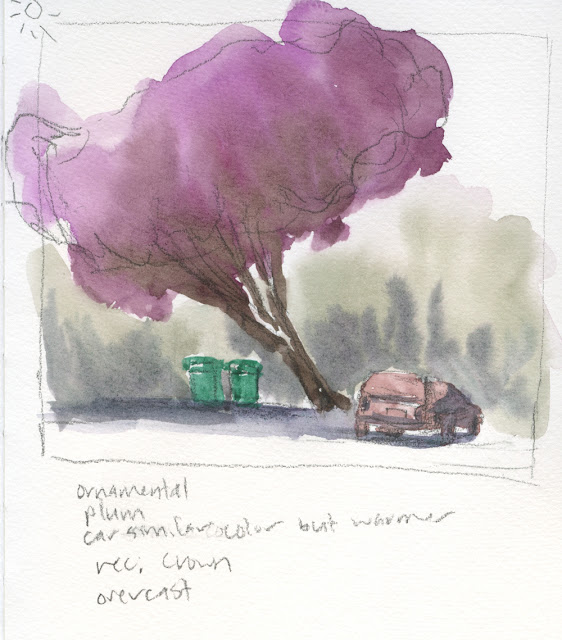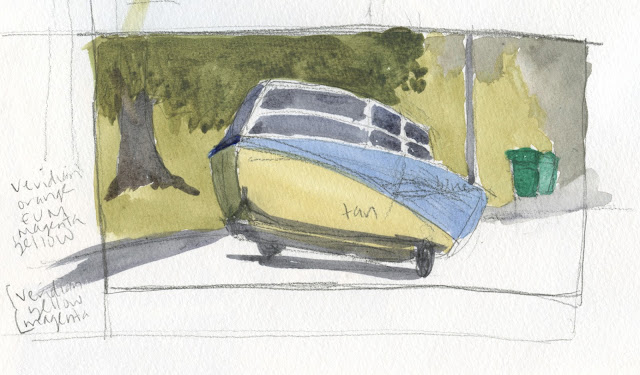 |
| 10/21/23 A warm-up sketch from memory while taking a walk. |
Whew – Kathleen Moore’s homework assignment for week 3 was a
serious brain bender: sketching from memory! Every day, we were to observe a
subject, look away, and then draw and paint it from memory. The principle is
that building visual memory skills helps us simplify and become faster, more
decisive and economical in recording what we see.
I immediately recalled insights I had gained from my own
self-challenge last year to draw from memory and imagination for 100 consecutive days. Back then, I had changed the variables to see how they
might affect my success, such as duration of time between observation and
drawing, and whether I took written notes. The single-most important variable
was how long I spent observing the subject: The longer I observed, the more
details I retained accurately. In addition, describing aspects I observed with
words to myself – “the faucet handle is twice as long as the base is wide; the
base looks like a lampshade” – helped immensely.
For my 100-Day Project, I made line drawings only, but an
additional challenge in Kathleen’s assignment was to include color. That turned
out to be the easiest part of the challenge: Lately I’ve been working toward
interpreting colors (instead of being tied to matching “reality”), even when
I’m sketching from observation, so painting from memory wasn’t too different.
It was important, though, to remember where the light was coming from.
Kathleen didn’t require that we work from life, but since
the weather was cooperative at least some of the time, I did all of my
exercises either from the sidewalk or from my mobile studio. As you can see, I usually
chose simple subject matter that I’m already familiar with drawing – the usual
cars, trees and street scenes. When I spotted the parked boat, I knew that
would be more challenging because I rarely sketch boats, so I gave that a go,
and it was definitely more difficult.
(In each case, I took a photo of the scene before I
began observing, but I didn’t peek until after the sketch was completely
finished. It was a good way to check how much I got right. Photo immediately following each memory sketch.)
 |
| 10/22/23 Sketch from memory. My brain remembered a more exaggerated lean to the tree and a sharper angle to the tree's crown, but I think those faulty memories improved the composition. |
I described details to myself as I observed (and when I was
alone in my mobile studio, I even said the descriptions aloud) – “the distance
from the handrail to the roof is about the same as from the handrail to the
bottom of the truck.” I even did this with color: “The recycle bins are
Veridian green; the car is a similar hue as the ornamental plum foliage except
slightly warmer.” (In my current palette, I am trying Veridian green, a
color I have never liked or had use for, but Kathleen has talked about
interesting mixes that can be made with it, so it was worth a try. Besides,
it’s an ideal recycle bin color!)
 |
| 1/23/23 sketch from memory |
What surprised me most about these exercises is that I think some are better than similar sketches I’ve made while drawing directly from observation. When sketching from memory, I was no longer a slave to what I was actually seeing, so I was more at liberty to improve the composition or simplify the scene more than I normally might. That was quite an interesting result that I hadn’t expected.
 |
| 10/24/23 Sketch from memory. I have made many sketches with similar elements, but I like this one better than some I've done because I was more willing to simplify. |
 |
| 10/25/23 Sketch from memory. This was by far the most difficult because I don't get much practice sketching boats and their trailers. I correctly remembered that the power pole was in the center of the boat, but I erased it before painting and moved it to make a better composition. I used Veridian in most of the color mixes . . . yuck! It's not going to earn its keep in my palette if all I use it for is recycle bins! |
For week 3 we also made a color wheel and mixes. Kathleen demonstrated by using the traditional split primary triad system – a warm and a cool each of red, yellow and blue – but she encouraged us to use whatever paints we had.
Since my current watercolor palette is similar to the
colored pencil palette I have been developing for a while, I use only magenta
as the “red,” so I don’t have a warm red. (In my color wheel, I painted my
Daniel Smith Quinacridone Magenta wedge in the wrong space – it should be in
the space closer to violet – but since I don’t have a warm red to go in the
other red space, it doesn’t matter.) Another oddball exception in my wheel is
that I am using DS Green Gold as my cool yellow. When I dilute it, it’s really
quite yellow, so I think I can get away with it. I chose Winsor & Newton
Phthalo Turquoise as my cyan.
On the outer rim of the wheel, she suggested making swatches of whatever “convenience” colors we use. Shown to the right of the wheel and below are mixed complements to see what kinds of neutrals we can make. (You can imagine how gleeful this color geek was during that part of the exercise!)
Although I’ve made many, many color wheels over the years – mostly with colored pencils but plenty with watercolors, too – this one was by far the most informative. I think it’s because I’ve finally developed a better sense for what I want to do with color (and what I want color to do) in my sketches. That’s very different from following a palette “recipe” from a book or using an instructor’s recommended palette.





















































